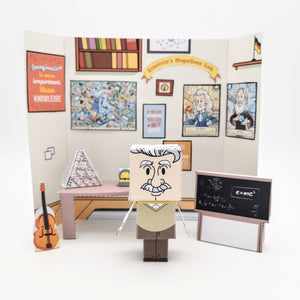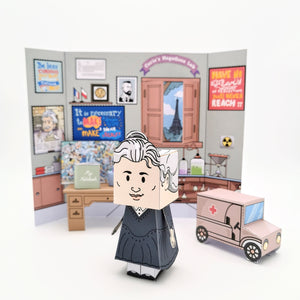Rosalind Franklin for Kids: Unlocking the Secrets of Life and DNA
🧬 Imagine trying to solve a puzzle with pieces so tiny, you can't see them with your eyes. Sounds impossible, right? Well, not for Rosalind Franklin, the incredible scientist who made history by uncovering the secrets of DNA! Get ready to be amazed by her story, full of twists, turns, and tiny building blocks of life. But beware: once you start reading about Rosalind's discoveries, you might just catch the science bug too!
- Born: July 25, 1920
- Died: April 16, 1958
- Nationality: British
- Education: St Paul's Girls' School, Newnham College (University of Cambridge), and King's College London
- Occupation: Chemist, X-ray crystallographer
- Best Known for: Pioneering work on the molecular structure of DNA, contributing to the discovery of the DNA double helix, Structures of viruses
The Early Years: Growing Up in an Influential Family
In the bustling city of London on July 25th, 1920, a brilliant scientist named Rosalind Franklin was born. She came from an influential British Jewish family, full of love and support. Her dad, Ellis Arthur Franklin, and her mom, Muriel Frances Waley, encouraged Rosalind and her siblings to learn and grow.
Rosalind was a curious little girl who loved asking questions about the world around her. Her family's passion for learning and helping others fueled her desire to explore the wonders of science. The Franklins believed that knowledge could make the world a better place, and Rosalind knew she wanted to be a part of that.
When Rosalind was old enough, she went to St Paul's Girls School, a prestigious school in London. She enjoyed her time there, discovering her love for science. She was especially fascinated by chemistry and physics, subjects that would later help her make groundbreaking discoveries.
While Rosalind was growing up, the world was facing a difficult time. The second World War had begun, and people everywhere were trying their best to support the war effort. Rosalind's family was no exception. Her father, Ellis Franklin, worked tirelessly to help refugees find a safe place to live. This sense of compassion and dedication to others inspired Rosalind throughout her life.
As Rosalind became more and more interested in science, she decided she wanted to study it further. Her family encouraged her to pursue her dreams, and she set her sights on attending one of the best universities in the world: Cambridge University. Little did she know that this decision would set her on a path to making history.
Paving the Way: Rosalind's Education and Pursuing Her Passion
Rosalind Franklin had big dreams and was ready to chase them. She went to Newnham College at Cambridge University to study science. Rosalind worked hard and soaked up all the knowledge she could. At Cambridge, she focused on physical chemistry, a subject that combined her love for chemistry and physics.
While studying at Cambridge, Rosalind was also involved in the war effort. She conducted research with the Coal Utilisation Research Association, studying British coal to help the country during World War II. Rosalind's work on coal taught her about solid organic colloids, a type of material that would later become important in her scientific journey.
After finishing her studies at Cambridge, Rosalind decided to learn even more. She traveled to Paris, France, to work with a talented scientist named Adrienne Weill. Under Adrienne's guidance, Rosalind learned about a powerful technique called X-ray diffraction. This technique allows scientists to take pictures of really small things, like molecules, to understand their shape and structure.
Rosalind also worked with another scientist named Jacques Mering. Together, they used X-ray diffraction to study the structure of various materials. Rosalind quickly became an expert in this field, and her skills would soon lead her to make groundbreaking discoveries.
While Rosalind was becoming an expert in X-ray diffraction, something big was happening in the world of science. Scientists all over the globe were racing to uncover the secrets of DNA, the building blocks of life. DNA is a tiny molecule that holds the instructions for making all living things, from plants to animals to people like you and me.
Rosalind's expertise caught the attention of a scientist named John Randall. He invited her to join his team at King's College London to use her skills to uncover the mysteries of DNA. Rosalind accepted the challenge, and her journey to unlock the secrets of life was about to begin.
The DNA Detectives: Rosalind Joins King's College London
When Rosalind Franklin arrived at King's College London, she was ready for a new adventure. She joined a team of scientists, including Maurice Wilkins and Raymond Gosling, who were also searching for the secrets of DNA. Together, they used X-ray diffraction to take pictures of DNA molecules, hoping to discover their structure.
Rosalind worked closely with a graduate student named Raymond Gosling. They were a great team, and Rosalind taught Raymond all about X-ray diffraction techniques. With Rosalind's expertise, they were able to take beautiful X-ray photographs that would help unlock the mystery of DNA's structure.
But the path to discovery wasn't always smooth. Rosalind faced challenges along the way. She didn't always get along with her colleague Maurice Wilkins, and they disagreed about the best way to study DNA. Despite these difficulties, Rosalind stayed focused on her work.
Meanwhile, in another part of England, two scientists named James Watson and Francis Crick were also trying to uncover the secrets of DNA. They knew that if they could figure out the structure of DNA, they could understand how life is built and how it grows.
One day, Rosalind and Raymond captured a stunning X-ray diffraction photo, which they called Photo 51. This picture showed the shape and structure of DNA more clearly than ever before. It was a major breakthrough, and it brought Rosalind one step closer to solving the mystery of DNA.
But Rosalind wasn't the only one looking at her photo. Without her permission, Maurice Wilkins showed Photo 51 to James Watson and Francis Crick. They were amazed by what they saw, and the photo helped them build a model of DNA's structure. This model, called the double helix, revealed how DNA's pieces fit together like a twisted ladder.
Rosalind continued her work at King's College London, unaware that Watson and Crick had seen her groundbreaking photo. She kept refining her own ideas about the structure of DNA, using her skills in X-ray diffraction analysis and her understanding of helical crystalline DNA.
A New Chapter: Birkbeck College and the Tobacco Mosaic Virus
After her time at King's College London, Rosalind Franklin decided to start a new chapter in her life. She moved to Birkbeck College in 1953, where she would continue her amazing work in science. At Birkbeck, Rosalind began studying a new mystery: the tobacco mosaic virus.
The tobacco mosaic virus, which is a part of the plant viruses family, is a tiny invader that attacks plants, making their leaves turn a strange, mosaic pattern. Rosalind wanted to understand this virus better, so she turned to her trusty X-ray diffraction techniques to take a closer look.
Rosalind's work on the tobacco mosaic virus was groundbreaking. She discovered that the virus had a unique structure, similar to a spiral staircase. This was important because it helped scientists understand how the virus could infect plants and cause disease.
During her time at Birkbeck College, Rosalind worked with a talented scientist named Aaron Klug. Together, they continued to study the tobacco mosaic virus, making important discoveries about its structure and how it worked. Rosalind's research on the tobacco mosaic virus laid the foundation for our understanding of many other viruses.
While Rosalind was making breakthroughs in her work on the tobacco mosaic virus, James Watson and Francis Crick were receiving recognition for their double helix model of DNA's structure. They, along with Maurice Wilkins, would later be awarded the Nobel Prize for their discovery. Sadly, Rosalind's important contributions to the discovery of the double helix were not acknowledged during her lifetime.
Rosalind Franklin's work at Birkbeck College was cut short when she became ill with ovarian cancer. Despite her illness, she continued to work and make important contributions to science.
Sadly, her illness continued to worsen, and she passed away on April 16, 1958, at the young age of 37. Her death was a huge loss to the scientific community.
The Legacy of Rosalind Franklin: Double Helix, Nobel Prize, and Beyond
Rosalind Franklin may not have lived to see the full impact of her work, but her discoveries have left a lasting legacy in the world of science. Her research on the structure of DNA helped to reveal the double helix, a discovery that has shaped our understanding of life and genetics.
James Watson, Francis Crick, and Maurice Wilkins were awarded the Nobel Prize for their work on the double helix. Although Rosalind's contribution was not recognized at the time, many people now know that her X-ray diffraction photographs played a crucial role in their discovery.
Rosalind's work on the tobacco mosaic virus also had a lasting impact. Her research helped scientists understand how viruses infect plants and animals, and it laid the foundation for future studies on other viruses and the field of structural virology. Today, her work continues to influence the study of diseases and the development of new treatments.
As the years passed, more and more people started to learn about Rosalind Franklin's incredible story. Books and documentaries have been created to celebrate her life and achievements, helping to ensure that her contributions to science are not forgotten. Rosalind Franklin is now considered a pioneer in the field of molecular biology.
In recognition of her groundbreaking work, many institutions and awards have been named in Rosalind's honor. These include the Rosalind Franklin University of Medicine and Science in the United States, and the Rosalind Franklin Award given by the Royal Society in the United Kingdom.
When we look back on the life of Rosalind Franklin, we can see that she was an extraordinary scientist who made remarkable contributions to our understanding of DNA and viruses. But her story is more than just a list of accomplishments. Rosalind's life is an inspiring example of perseverance, determination, and a passion for discovery.
Rosalind faced many challenges throughout her life. As a woman in the male-dominated world of science, she often had to work harder to prove herself. Despite these difficulties, she never gave up on her dreams or her love of learning. Rosalind's dedication to her work serves as a powerful reminder that we should never let obstacles stand in our way.
Fun Facts and Anecdotes: Get to Know Rosalind Elsie Franklin
-
Did you know that Rosalind Franklin loved to travel? During her time at Cambridge University, she spent a year in Paris working with French scientist Adrienne Weill. Rosalind learned valuable X-ray diffraction techniques from her and fell in love with French culture. She enjoyed exploring new places and learning about different cultures throughout her life.
-
Rosalind was known for her incredible work ethic. Her colleagues at King's College London often found her working late into the night. She believed that dedication and hard work were essential for success in her research.
-
While Rosalind was an excellent scientist, she also had other interests. She enjoyed hiking, photography, and playing the piano. In her free time, she could often be found exploring the countryside or taking beautiful photos.
-
Rosalind had a knack for languages. She was fluent in French and had a good knowledge of German and Italian. Her language skills were useful in her collaborations with international scientists.
-
Rosalind Franklin was given the nickname "The Dark Lady of DNA" by her colleagues probably due to the fact that her significant contribution to the discovery of DNA's structure was not recognized at the time.
-
Did you know that Rosalind Franklin's research on coal during World War II helped the war effort? Her work with the British Coal Utilisation Research Association contributed to the development of better gas masks for soldiers and improvements in fuel production.
-
Rosalind had a unique way of taking notes during her research. She used a special shorthand method she developed herself to write down her observations quickly and efficiently.
-
As a child, Rosalind attended St Paul's Girls School, where she excelled in both academics and sports. She was a skilled tennis player and also enjoyed playing hockey.
-
During her time at Newnham College, Rosalind was awarded a research fellowship to study physical chemistry. This fellowship allowed her to work with some of the top scientists in her field and helped pave the way for her future discoveries.
-
Rosalind was known for her strong sense of justice and fairness. She believed in equal opportunities for everyone and always stood up for what she believed was right. Her determination to fight for equality is an inspiring aspect of her character and legacy.
Rosalind Franklin Frequently Asked Questions (FAQ)
What was Rosalind Franklin best known for?
Rosalind Franklin's scientific discoveries were groundbreaking and had a significant impact on the field of molecular biology. Here are her most significant discoveries and achievements:
The structure of DNA: Rosalind Franklin's X-ray diffraction images of DNA played a crucial role in the discovery of the double helix structure of DNA. Her Photo 51 provided important clues about the shape and structure of DNA, which were used by James Watson and Francis Crick to build their model of the double helix. This discovery revolutionized our understanding of genetics and paved the way for modern molecular biology.
The structure of viruses: In addition to her work on DNA, Rosalind Franklin also studied the structure of the tobacco mosaic virus. She used X-ray diffraction to determine that the virus had a helical structure, similar to a spiral staircase. This was an important discovery because it helped scientists understand how viruses infect plants and animals, and it laid the foundation for future studies on other viruses and the field of structural virology.
Solid organic colloids: During World War II, Rosalind Franklin conducted research with the Coal Utilisation Research Association, studying British coal to help the country during the war. Her work on coal taught her about solid organic colloids, a type of material that would later become important in her scientific journey. She used this knowledge to study other solid organic colloids, including DNA and viruses, which led to her groundbreaking discoveries in these areas.
The B-form of DNA: Rosalind Franklin's work on the structure of DNA also revealed the existence of the B-form of DNA, a different conformation of the molecule that plays an important role in DNA replication and stability. This discovery helped scientists understand the complex interactions between DNA and the proteins that interact with it, and it has led to important advances in genetics and biotechnology.
Overall, Rosalind Franklin's scientific discoveries were instrumental in shaping our understanding of genetics, viruses, and the molecular basis of life. Her contributions to the field of molecular biology continue to influence scientific research and inspire future generations of scientists.
What is X-ray diffraction?
X-ray diffraction is a special technique that scientists use to look at really tiny things, like molecules. They use X-rays, which are a type of light that can pass through solid objects, to take pictures of these tiny things.
When X-rays hit a molecule, they bounce off in different directions. Scientists can then measure how the X-rays bounce off the molecule to create a pattern. This pattern helps them understand the shape and structure of the molecule.
It's like shining a flashlight on a crystal and seeing a pattern of light on the wall behind it. That pattern helps you understand the shape of the crystal. X-ray diffraction is a bit like that, but with X-rays instead of a flashlight, and molecules instead of crystals.
Rosalind Franklin was really good at using X-ray diffraction to take pictures of molecules, which helped her make important discoveries about DNA and viruses.
Who were James Watson and Francis Crick?
James Watson and Francis Crick were two scientists who are famous for discovering the double helix structure of DNA in 1953. They worked together at the University of Cambridge in England, and their discovery revolutionized our understanding of genetics and molecular biology.
Rosalind Franklin's work on X-ray diffraction images of DNA was instrumental in helping Watson and Crick build their model of the double helix. However, at the time, Franklin was not recognized for her contribution to the discovery of DNA's structure. Watson and Crick published their discovery in the scientific journal Nature, without properly acknowledging Franklin's work.
It wasn't until after Franklin's death that her contributions to the discovery of DNA's structure were fully recognized. Today, we understand that Franklin's research was crucial in paving the way for Watson and Crick's famous discovery.
How did the discovery of DNA change the world?
It revolutionized our understanding of genetics and molecular biology, and led to many important advances in medicine, agriculture, and other fields. Here are some ways that the discovery of DNA changed the world:
Understanding genetic diseases: The discovery of DNA's structure allowed scientists to understand the genetic basis of many diseases. This has led to the development of new treatments and cures for diseases like cystic fibrosis, sickle cell anemia, and many others.
Genetic engineering: The ability to manipulate DNA has led to many advances in genetic engineering, allowing scientists to create new medicines, crops that are resistant to pests and environmental stresses, and other important innovations.
Forensic science: DNA analysis has become an important tool in forensic science, allowing investigators to identify suspects and solve crimes based on DNA evidence left at the scene.
Evolutionary biology: The discovery of DNA's structure has helped scientists better understand the evolution of species and the relationships between different organisms.
Overall, the discovery of DNA's structure has had a profound impact on science and society, and continues to inspire new discoveries and innovations today.

















